U.S. Navy's Low Frequency Active Sonar Research Exposed |
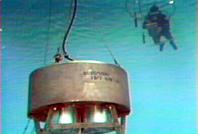
SURTASS LFA undergoing tests (Photo U.S. Navy) |
The Tyack Permit
Prepared by
Lanny Sinkin
P. O. Box 944
Hilo, Hawai`i 96721
(808) 961-9100
January 31, 2001
The author of this paper is an attorney in Hilo, Hawai`i. In 1998, he filed two suits challenging the U.S. Navy testing of a low frequency sonar system on whales. In 2000, he filed a third suit challenging the Navy's continued spending on development and deployment of the system despite the absence of a final environmental impact statement.
|
Overview:
In the early 1980s, the U.S. Navy identified as a special threat the new, quieter generation of submarines being built by the Soviet Union. The undersea passive sonar systems deployed throughout the world by the U.S. Navy supposedly would not be able to detect these new submarines.
The Navy conducted a review of available technology and selected the alternative of low frequency active sonar as the best response. The Navy made this decision without preparing an environmental impact statement
(EIS) on the potential damage this technology could cause to the ocean environment and ocean life.
The Navy proceeded to design, engineer, fabricate, and test this system in remote areas of the world. The Navy took the position that these tests did not need permits under the Endangered Species Act (ESA) or the National Environmental Policy Act (NEPA). The Navy's internal documents reveal that the Navy was well aware that the low frequency sounds might be harmful to cetaceans. The entire development and testing process took place in secret.
In 1995, the Natural Resources Defense Council discovered the program and wrote the Navy a letter citing numerous laws being violated by the development and testing program.

Peter L. Tyack
Woods Hole Oceanographic Institution |
In 1996, the Navy agreed to prepare an EIS for the system, known as SURTASS LFA. As part of preparing the EIS, the Navy also agreed to perform a Scientific Research Program (SRP) for low frequency active sonar (LFAS). Dr. Peter Tyack of the Woods Hole Oceanographic Institution participated as a member of the SRP team.
In the three phases of the SRP, the research revealed that whales diverted from their normal migration routes to avoid the sound, that whales ceased singing in response to broadcasts of the sonar, and that whale songs changed after broadcasts. The testing took place at broadcast levels thousands of times less than the levels to be used by the Navy during routine operation of the system.
In 1998, the SRP conducted research off Hawai`i under a permit from the National Marine Fisheries Service (NMFS). These tests resulted in numerous reports from whale watch captains and shore observers that the Humpback Whales fled from the test area. A snorkeler exposed to a broadcast emerged from the water with symptoms a doctor compared to a trauma patient in a hospital. A separated Humpback Whale calf and a separated dolphin calf appeared during the testing. A separated melon head whale calf appeared shortly after the testing.
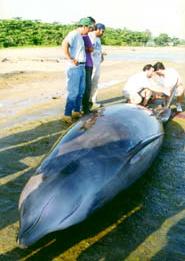
A beached goosebeak whale in the Caribbean. (Photo Laboratorio de Mam’feros Marinos del Caribe) |
Based on this evidence and other reports of adverse effects, various groups and individuals filed lawsuits against the Navy, the National Marine Fisheries Service (now NOAA Fisheries), and other federal agencies.
The Navy terminated the tests and convinced the judges to dismiss the cases remaining as moot because the research was complete and the Navy did not intend any further testing.
In March 2000, the Navy's research manager of the LFA program sent an email detailing plans to conduct further tests off the Azores, Dominica, and possibly Hawai`i. An NMFS staff member referred to this research as Phase IV of the SRP. The Hawai`i County Green Party moved to reopen the suit it filed in 1998.
In response, the Navy filed an affidavit from the program manager saying that no such research was going to be funded or conducted.
In May 2000, Dr. Peter Tyack filed an application with NMFS to conduct low frequency active sonar testing on whales in the Azores to begin in July.
Neither the application nor the Federal Register Notice of the application prepared by NMFS referred to the testing as including low frequency active sonars.
In August 2000, NMFS granted Dr. Tyack a five-year permit to conduct such research. The permit allowed harmful impact on the whales far in excess of anything permitted in the 1998 tests.
To summarize:
- -- the Navy conducted secret tests of a technology known to be potentially harmful to cetaceans without obeying the applicable environmental laws;
- -- after the existence of the technology and the testing program came to public attention, the Navy conducted a minimal research program examining only a few of the potential effects on a very limited number of ocean species;
- -- when adverse effects became public and led to litigation, public controversy, congressional calls to suspend the program, and other undesirable impacts, the Navy backed out of directly funding further research;
- -- the Woods Hole Oceanographic Institution permitted Dr. Peter Tyack to provide an alternative to the Navy research;
- -- the National Marine Fisheries Service cooperated with Dr. Tyack to disguise the nature of the research and to permit the research to be conducted far from U.S. waters. Dr. Tyack is required to file a report only once a year. Locating the research in the Azores and limiting reports to once a year means that the network of individuals and organizations opposed to deployment of this technology will be prevented from monitoring the research.
Having begun as an illegal, secret program, LFAS surfaced briefly to reveal its true nature. Woods Hole Oceanographic Institution and NMFS then cooperated to take the program back into a semi-secret level to avoid further exposure.
Tyack Permit Request
Background
On May 15, 2000, Dr. Peter Tyack submitted an application to the Office of Protected Resources, National Marine Fisheries Service requesting permission to conduct scientific research "and to enhance the survival and recovery of a stock under the Marine Mammal Protection Act and the Endangered Species Act." Cover letter from Dr. Peter Tyack to Ms. Ann D. Terbush dated May 15, 2000.
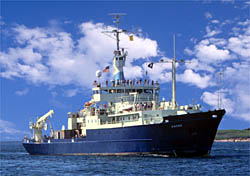
The Research Vessel Knorr is a U.S. Navy-owned ship
operated by the Woods Hole Oceanographic Institution
(WHOI) for ocean research. |
This permit request is submitted from Woods Hole Oceanographic Institution (WHOI). WHOI operates ships equipped with transducers capable of playbacks similar to SURTASS LFA in both frequency and power levels. In the past, tests or experiments used WHOI equipment to expose marine mammals to low frequency sonar. The use of WHOI equipment permitted the U.S. Navy to take the position that SURTASS LFA was not being used in such tests or experiments, e.g. the Navy position in federal court regarding proposed testing off New York and New Jersey, known as the LWAD 002 tests.
The history suggests that WHOI is a surrogate for the Navy in such tests or experiments. The close linkage between Dr. Tyack and the Navy suggests Dr. Tyack is the facilitator to put the surrogate in place. In the Scientific Research Program for SURTASS LFA, Dr. Tyack acted directly in concert with the Navy. In his latest permit, Dr. Tyack shields the Navy from further involvement in LFAS testing and removes the research from public view.
The Federal Register Notice
The June 30, 2000 Federal Register Notice of the Tyack permit application is remarkably uninformative. Federal Register: June 30, 2000 (Volume 65, Number 127, Page 40613-40614.)
The notice states that the permit application seeks permission to harass various species of cetaceans in the North Atlantic and Mediterranean Sea "during the course of research on the impact of noise on marine mammals." The notice also states that the harassment will include "playbacks of sound." These two references are the only information regarding Dr. Tyack's intent to use sound generating equipment impacting cetaceans. There are no references to the frequencies to be used and certainly no mention of low frequency sound.
It is worth noting that this permit application was being submitted in the midst of active litigation regarding the testing of low frequency active sonar on cetaceans. On March 14, 2000, the Hawai`i County Green Party filed a motion to reopen a 1998 case that challenged Navy LFAS testing. The Green Party based its motion on an email from a research program manager at the Office of Naval Research (ONR). The March 1, 2000 email stated that discussions were underway with Dr. Tyack and others to conduct tests of LFA on cetaceans in the Azores, Dominica, and possibly Hawai`i. The basis for the motion to reopen was that the Navy had represented to the court in 1998 that the LFA research was complete and that no further testing of LFA would be taking place prior to the issuance of a final EIS on the SURTASS LFA system. Based on that representation, the court had dismissed as moot the 1998 suit seeking to enjoin such testing. The intent to resume testing LFA appeared to the plaintiffs to be a change in the Navy's earlier position that warranted reopening the case.
On May 26, the Navy submitted a declaration from the ONR research manager stating that the proposed research would not have used the actual SURTASS LFA system. Instead, the research "would have used any one of a number of standard research transducers."
The ONR research manager stated that the research discussed in the email "never got beyond the discussion phase." He further stated that "to the extent any permits would have been necessary, they were never obtained." He concluded that "the research I referred to will not be carried out this year."
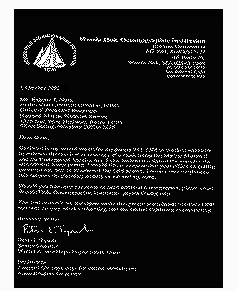
WHOI Application |
Yet ten days earlier, Dr. Tyack had filed the application to begin such tests in the summer of 2000. The appearance is that the motion to reopen the 1998 litigation made the continued participation of ONR too risky, so Dr. Tyack substituted WHOI for the U.S. Navy to pursue the research that ONR said would not be conducted.
A month later, the NMFS filed the Federal Register notice of Dr. Tyack's application. At that time, the litigation had not been resolved.
Thus, in March 2000, ONR was discussing with Dr. Tyack research in the Azores into the impact of LFA broadcasts on cetaceans. After the filing of suit to reopen the 1998 case, those discussions apparently terminated with Dr. Tyack pursuing the same or similar research apparently relying on funding sources other than ONR.
NMFS was a party to the 2000 litigation. NMFS (and their government lawyers) failed to mention to the court the application from Dr. Tyack contradicting the ONR position that no such research was going to take place.
The Permit Request
The permit request is dated May 15, 2000. In the cover letter, Dr. Tyack apologizes for allowing "a little less than [NMFS’s] six months lead time." The letter states that the Azores fieldwork is to begin on July 28. So the actual lead-time is just over two months, rather than six months. Referring to this reduction as "a little less" than six months is indicative of Dr. Tyack's treatment of data to support his position, i.e. an application providing approximately one third the amount of review time requested by the agency is not late.
The NMFS rejected a Navy application for sonar testing in LWAD 002 in part because the Navy failed to provide sufficient time for review of that application. In that case, the time provided was something on the order of thirty days. The LWAD 002 test, however, had a very short duration. The Tyack permit request is for a five-year period. The potential impacts of such a long term program of exposure would seem to call for a higher level of scrutiny, i.e. more than the normally requested six month lead time. NMFS ultimately issued the permit on August 31, 2000, approximately three and a half months after the application.
The expedited treatment of this long-term permit is typical of the cozy relationship between NMFS and the WHOI/Navy nexus. The issuing officer for NMFS is Eugene Nitta. In 1998, Mr. Nitta was in charge of enforcing an NMFS permit for SURTASS LFA testing on Humpback Whales off Hawai`i. That permit required immediate suspension of the testing, if an abnormal absence of animals occurred. Mr. Nitta is the NMFS official who refused to order the testing suspended when numerous whale watch boat captains and shore observers reported that the whales had left the testing area when the broadcasts began. Mr. Nitta was subsequently promoted to the national NMFS office.
The Team
It appears that Dr. Tyack assembled a highly qualified team of researchers in the bioacoustic field. Some of these researchers had previous involvement with the SURTASS LFA SRP.
The Research
The essence of the first phase of the research appears to be tagging animals, establishing a base line of animal behavior, and then exposing the animals to sounds to determine when avoidance behavior takes place. Eighteen different species will be subject to exposures from the playbacks. When the tags slough off the animal, samples of skin tissue will be attached which will then be analyzed.
The Playbacks
The information about the proposed playbacks is remarkably limited. The maximum proposed "sound exposure level" will be 160 dB. (p. 18) The sound exposure level is presumably what is normally referred to as the received level, i.e. the sound level reaching the target animal as opposed to the sound level at the sound source. Received levels will begin at 120 dB and be increased if no "disturbance reaction" is observed. (p. 18) This initial description of the playbacks contains no information about the frequency level, as opposed to the power level. (p. 18-20)
The second description of the playbacks also contains no information about the frequency. (p. 24) This discussion does state that playbacks will be targeted at Sperm Whales in the Azores and multiple species in the Ligurian Sea. The Ligurian Sea is an arm of the Mediterranean Sea between the islands of Corsica and Elba and the Riviera coasts of northwestern Italy and Monaco.
The third discussion of playbacks contains no frequency information. (p. 26) This discussion does discuss the rationale for limiting the exposure level to 160 dB in the Ligurian Sea. The SACLANT Undersea Research Centre of NATO operates in this sea and has adopted a 160 maximum as the level above which some harm might result and below which there is low risk of harm. The WHOI research will test this assumption below 160.
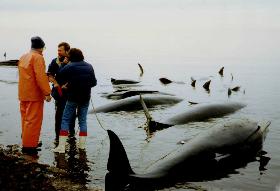
(Photo NMFS) |
There is no basis for assuming that 160 dB is a safe level of exposure for cetaceans. Until a NATO LFAS exercise apparently killed numerous whales in the Mediterranean and the Draft EIS justifying deployment of SURTASS LFA came out, the scientific community routinely used 120 dB as the safe level of exposure. NATO and the Navy assume a higher level to be safe and reinforce each other. The existing evidence does not support raising the safe level from 120 dB.
SACLANT/NATO is the group responsible for studying the strandings of numerous Curvier Beaked Whales coincident with a NATO use of LFA. Based on that experience, the effects of low frequency sonar on cetaceans would be the central concern of SACLANT/NATO and the 160 dB level would be most relevant to low frequency impacts. The Tyack application does not discuss the LFA connection to SACLANT/NATO at this point in the application. In avoiding that discussion, Dr. Tyack avoids explaining that in order to test the SACLANT/NATO 160 dB assumption, the research will have to use LFA to be relevant.
Later in the application, Dr. Tyack discusses the background and current knowledge relevant to this project. (p. 28) In this section, Dr. Tyack does note that low frequency sounds are increasingly being broadcast into the marine environment. "Loud low frequency sound sources are increasingly being employed for long range sonar, research, and communications." He specifically notes the "[l]ow frequency sonars for military use such as the LFAS system used by the NATO SACLANT center" and the U.S. Navy's SURTASS LFA.
The background discussion at page 28 is the first time Dr. Tyack addresses the low frequency sonar issue. While discussing specific power levels of such sound sources, Dr. Tyack does not address the frequency ranges. As Dr. Tyack acknowledges, the "zone of influence of a sound source depends upon its level, its frequency spectrum, and upon the conditions for sound propagation near the source." (p. 28)
In his next discussion of the playbacks, Dr. Tyack again restricts his discussion to solely the power level of the broadcasts, with no information about the frequency levels. (p. 29-30.)
The first indication of frequency levels appears at page 31 where Dr. Tyack refers to "Chirp upsweeps centered at 1kHz, 2.5kHz, 4kHz, 8kHz, 12kHz." As it turns out, the key word in that description is "centered." As it also turns out, the representation of 1kHz as the low-end center point is false.
The calculation of the third octave band is complex as it involves logarithmic calculations and a geometric mean. An approximate calculation is that the range would be from 766 Hz to 965 Hz. The frequency range of the Sanders Model 30 is, therefore, either completely or alsmost entirely in the low frequency range. The treatment of this device is "centered at 1Hz" or "centered at near 1 Hz" is obviously a deception intended to hide the true, low frequency nature of the broadcasts.
The truth begins to unfold when Dr. Tyack discusses earlier experiments by Watkins, noting that Watkins used "a Sanders Model 30 sound source to playback a phase-modulated signal covering about a third octave band centered on 860 Hz to sperm whales in the Windward Islands." (p. 32) The customary delineation is that anything below 1kHz is low frequency. Obviously, 860 Hz is low frequency. Dr. Tyack avoids providing the information on the frequency range above and below the centering point, other than describing it as a third octave band, leaving the reader to research the frequency range that description represents. The omission is part of avoiding any description of this research as low frequency active sonar. Referring to chirp upsweeps "centered at 1kHz" which are actually centered at 860 Hz is similar to referring to a two-month lead-time as a "little less" than the six months requested by the agency.
As to the new permit application, Dr. Tyack stated that "[f]or playbacks near 1kHz, we propose to use the same WHOI Sanders Model 30 source used in the initial Watkins playbacks, a source which has a frequency response centered near 1kHz." (p. 33) The earlier "centered at 1kHz" is now "centered near 1kHz." Again two months is only a "little less" than six months.
There is nothing cynical about observing that Dr. Tyack is carefully avoiding any admission that his research intends to broadcast low frequency active sonar at whales. The Sanders Model 30 sound source is centered in the low frequency range. While 860 kHz may be "centered near 1kHz," as per Dr. Tyack's description, 860 kHz is obviously low frequency and is the centering point, which means the source goes even lower. To describe this source as "centered near 1kHz" is obviously an attempt to deflect attention from the intent to use LFA on whales.
Dr. Tyack notes that one of the researchers involved in the current application did previous research on Sperm Whales similar to Watkins and found differing results. "By contrast Gordon et al. (1996) played back similar stimuli at 75 Hz, 800 Hz, 1kHz, 2kHz, 3 kHz, and 4kHz to sperm whales in the Azores." (p. 33). Dr. Tyack proposes to reconcile the discrepancies between the Watkins and Gordon research. To do so would appear to require using frequencies in the low frequency range.
Dr. Tyack repeats the description of the research at page 34 as:
"playback stimuli with frequencies similar to those used in the Gordon et al. (1996) and Watkins (pers com.) playbacks. These would include signals with center frequencies of 860 Hz and 1.2 kHz. These signals will have bandwidths of about one-third octave." (p. 34).
The permit application contains extensive description of the Acoustic Recording Tag, including the weight, length, width, height, etc. (p.36-37). There is no description of the Sanders Model 30, other than the limited information found in the text of other discussions noted above. There is no information provided anywhere in the application on the actual frequency range of the source.
To return for a moment to Mr. Nitta, before I had any of these documents, I called Mr. Nitta to discuss the Tyack application and raised the low frequency issue. Mr. Nitta said that Dr. Tyack would not be using low frequency and read me the "chirping upsweeps" reference starting at 1kHz found on page 31 of the application. In the copy of the application I received from Mr. Nitta, almost all the references to the Sanders Model 30 centered at 860 Hz are either underlined or otherwise highlighted. Obviously, Mr. Nitta knew that Dr. Tyack's research involved LFA and his telephone comments had sought to deflect my attention from that fact. Had I abandoned by inquiry at that point based his misrepresentations, I would never have discovered the information presented in this paper.
The Permit
The most obvious omission from the permit is any mention of frequency ranges for playbacks. The permit is tied to the application, so presumably Dr. Tyack is free to use the sound source at any frequency he chooses.
Under this permit, the researchers are permitted to harass animals. In this case, harassment can include "interruptions of breeding, nursing, or resting activities; attempts by a whale to shield a calf from a vessel or human observer by tail swishing or by other protective movements; or the abandonment of a previously frequented area." (p. 2, note 2.) The limitation comes later in the permit, to wit "an approach or specific research activity must be discontinued if during the approach/activity either target animals (i.e. those being actively studied by the researcher) or non-target animals exhibit three instances of harassment per day." (p. 5 underlining in original).
Under the 1998 permit, any abnormal absence of whales or serious disruption of their behavior would have been cause to immediately suspend the testing. There was no "three strikes" permission in the Hawai`i 1998 permit. There was no permission to seriously disrupt cetacean behavior on a daily basis as long as there were less than three such disruptions per day. This permit appears to allow activities that would have been forbidden completely in the 1998 testing. The new Tyack permit conditions are a major expansion of what constituted permissible harassment in 1998.
In the Azores and Ligurian Sea there will be no Ocean Mammal Institute, volunteer shore observers, or other citizens to watch over Dr. Tyack's practices. We will have the same researcher (Tyack), who refused to suspend the Hawai`i testing when the whales fled the test area, monitored by the same federal official (Nitta), who failed to enforce the permit conditions in Hawai`i. We will also have a permit allowing far more harmful activity to fall within permissible activity than did the 1998 permits.
There is a large constituency of people very concerned about low frequency sonar and its impact on marine life. Five lawsuits, an international Internet network, numerous national environmental organizations on record, and other elements of a widespread opposition to the deployment of this technology are known to the NMFS. Obviously a permit application for a five-year research program impacting cetaceans with LFA and permitting harmful disruption at far higher levels than ever permitted before would be a matter of great concern to that constituency.
I note that NMFS provided me a copy of an August 2000 application from the Scripps Institution of Oceanography for the operation of a low frequency broadcast station on Kaua`i without my having requested a copy. I assumed that represented an NMFS acknowledgement that as the attorney who had filed three of the lawsuits to date on LFA, I had an ongoing interest in the topic and would wish to file comments on any such application. NMFS did not provide me a copy of the Tyack application (nor to anyone I am aware of in the LFA network).
Clearly, Dr. Tyack designed his application to hide the intended use of LFA and the NMFS Federal Register notice cooperated in this deception. The apparent goal was to prevent concerned citizens from knowing about or participating in the decision process. The proof of that deception is that none of the organizations or individuals concerned about LFA had any input to the permit decision-making process. The Federal Register Notice apparently appeared so benign that these opponents of LFA use saw no reason to pursue the matter.
Perhaps Dr. Tyack designed and applied for permits to conduct a research program that is necessary to convince him and others that LFA is potentially harmful to cetaceans. Most of us believe that the evidence is already convincing on that point. It is hard to look upon this research as benign, however, in light of the history to date. The obscure nature of the Federal Register notice, the deliberate obfuscation in the permit application, and the blank check in the permit itself all suggest that the intent is to avoid public oversight and accountability. That the research will take place out of sight and far from any ability of our network to closely monitor what is happening only increases our level of concern.
There is even more cause for concern based on a Canadian Broadcast Company report titled "New military sonar harms whales: scientist" found at:
http://cbc.ca/cgi-bin/view?/news/2001/01/02/sonar010102
This article cites Dr. Tyack as stating that the LFAS is no more harmful to the whales than the noise from whale watching boats. While there may be differences of opinion on the potential damage LFA can do to whales, there are few in the scientific community who could compare the power of LFA with the noise from a whale watch boat.
In the past, Dr. Tyack attempted to walk the line of keeping his scientific integrity while interpreting his results in a manner designed to avoid alienating his potential naval funding. Dr. Tyack appears to have gone over completely to the Navy's position. The objectivity of his research is thereby further compromised.
With the obvious interest of citizens and organizations internationally and members of the U.S. Congress in the LFAS program, the actions of Woods Hole Oceanographic Institute and the National Marine Fisheries are a disservice to the public and the public interest.
To learn more about the previous federal lawsuits regarding Low Frequency Active Sonar, please visit
http://listen.to/lfas viewpoints.
To News MENU





